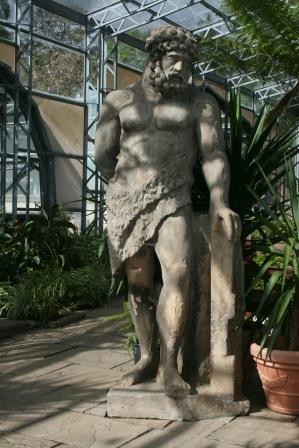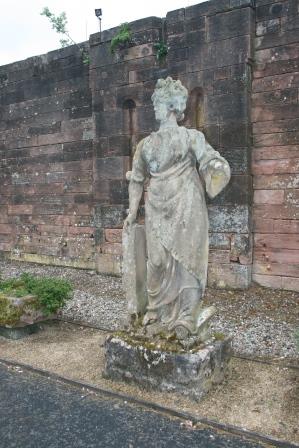
Viewpark House and Gardens

Viewpark House was built around 1835 on the east of the village of IUddingston. by Glasgow building contractor William Robertson. Situated on the southern slope of a ridge overlooking the Vale of Clyde, with commanding view's from Tinto in the east to the hills above Greenock in the west, and surrounded by trees, the large, impressive mansion was designed in late Tudor style by noted Glasgow- architect John Baird, whose business and reputation rivalled that of Glasgow's foremost architect of the period, Charles Hamilton, and who was responsible inter alia for the Argyll Arcade and much of South Woodside and Claremont in Glasgow. Viewpark. his first country house, was later to be followed by others like Cairnhill in Airdrie and Urie in Stonehaven. The gardens of Viewpark were small, only an acre in extent, hut incorporated a well-stocked greenhouse and a detached Vinery. Robertson died at Viewpart at the age of 63 in 1850.
In 1852, the 106 acre mineral rich Viewpark estate, by that time intersected by the new Edinburgh to Glasgow road and by the Clydesdale Junction Railway, which had opened Uddingston Station about a mile and a quarter east of the mansion, was purchased for around £9.000 by ironmaster Robert Addle, then the tenant of neighbouring Rosehall House. Addie. whose father had been overseer on the Earnock estate, near Hamilton, before moving in 1807 to occupy the same position on the Aidrie estate, ventured into coal mining in 1837, when with his partner, Robert Miller, he look a Iease of the minerals on the Whiteriggs estate. In same the year, again with Miller, he leased the minerals on the Rosehall estate, which became the main source of supply for his Langloan Iron Works which he opened with Miller and Patrick Rankin in 1841 on the Drumpcllier estate. Addie extended boundaries of his Viewpark purchase, acquiring potions of contiguous land, until it was said his estate had cost him £40,000. He also spent lavishly on additions and improvements to the mansion, including introducing gas and installing a bowling green. Addie, also proprietor of several farms to the east of Airdrie, became sole owner of the Langloan Company in I860 after buying out his partners. Among his contributions to the local community, Addie, in 1865, commissioned Thomas Halket to handsome new hotel in Bothwell, which at the time lacked suitable accommodation for the better class of tourist then visiting the locality.
When Addie died in 1870, management of the family business was assumed by his sons John, James and Gavin. John Addie (1842-1904), the eldest, had for many years sole responsibility for the Viewpark and Rosehall Collieries, besides being associated with the Langloan Ironworks. Viewpark House was to his home for the rest of his life. When the family firm went public in 1893, John Addic became chairman of the new company, Robert Addie and Sons Collieries, which assumed ownership of colieries of Rosehall, Viewpark, Herberyshire, and Killermont, and Benhar, whose combined output was 470,000 tons of coal, and increasing. TIhe area of workable coal within the leases held exceeded 3,000 acres and was estimated to contain upwards of 30 million tons of coal.
The Addies vacated Viewpark House alter the death Addie in 1904. Five years laler the Social Committee ol the Church of Scotland took a 10-year lease of the mansion and two acres of ground, remodclled and refitted the house, and opened a rescue home for women on the premises. Rescue homes, normally associated with churches or organisations such as the Salvation Army, were a contemporary response to the plight of woemn and girls who had “fallen in the world”. Thet targetted the unfortunate, the destitute, the in ebriate and those at risk from moral hazard, and aimed to rehabiliate them with a view to them leading self-respecting lives. Inmates were expected to help themselves by their own industry, and to this end laundry work, market gardening, sewing and waste paper sorting were part of thei regime for the 40 inmates of Viewpark Home in 1909. In 1915, Robert Addie and Sons offered Viewpark House as a temporary home for Belgian refugees. After the last refugees, 11 adults and 26 children, left Viewpark in 1919, the home was closed,
Immediately after the war Lanarkshire County Council acquired part of the Viewpark estate for housing, with a view to erecting 5,000 houses within a three year period at an estimated cost of £4 million. The first instalment of 200 houses began to be built on a site to the cast of Viewpark House, between Edinburgh Road and Old Edinburgh Road, in 1919. The mansion passed through a number of hands and by the 1940s had been sub-divided into fiats for occupancy by working class families.
Watling Street, the famous Roman road which stretched from Dover on the south coast to Carriden on the Firth of Forth, passed through the lands of Viewpark, and it is reported that some Roman artefacts were dug up on the estate in the early 19th century. Viewpark Colliery closed in February 1942, when the workable and accessible coal was exhausted. Viewpark House, which stood in the grounds of Viewpark Gardens on New Edinburgh Road, was demolished in the early 1950s.






